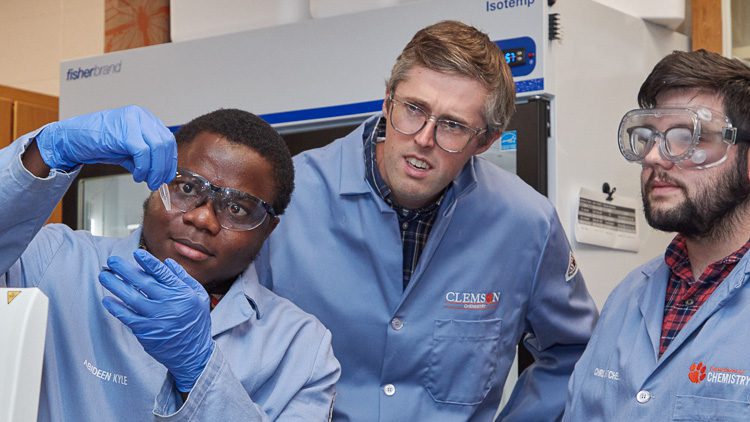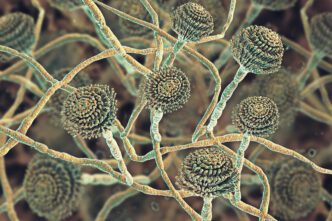Membrane proteins are crucial for cell function, and they are common targets for scientists researching potential therapeutic drugs to treat or prevent human health conditions.
But they live in a complicated chemical environment. Membrane proteins have contact with the primarily water-based environment both inside and outside the cell but are also embedded in a lipid bilayer, which is a double layer of lipid molecules that forms a barrier, separating the cell’s interior from its external environment.
“Membrane proteins live in the boundary that separates the cell from the world. They are of particular interest because they control and regulate a cell’s interactions with its surroundings. Whenever something needs to enter or exit a cell, it’s going through a membrane protein or is participating in a process that is mediated by membrane proteins,” said David Jacobson, an assistant professor in the Clemson University Department of Chemistry.
“Biologists are interested in membrane proteins because they play important roles in various pathways and they are drug targets. As a chemist, I think membrane proteins are cool because they live in this unusual environment,” he said.

Jacobson has received a $1.05 million National Science Foundation CAREER grant to better understand the forces that drive proteins to adopt a particular structure and the interactions that structure has with other molecules, including other membrane proteins. His research group is studying these questions by using atomic force microscopy to manipulate individual membrane proteins one at a time.
The NSF CAREER Award is among the most prestigious in the nation for early-career faculty who have the potential to serve as academic role models in research and education and to lead advances in their field.
Interesting chemistry and biophysics
“There’s a lot of interesting chemistry and biophysics at play in trying to understand at a molecular level why and how membrane proteins do what they do,” he said. “We’re trying to understand how membrane proteins adopt their structures in the cell and how they interact with each other and with biological processes.”
About 30% of proteins are membrane proteins.
Proteins are made of long strings of amino acids folded into three-dimensional shapes. By folding into distinct shapes, proteins can perform different tasks despite being composed of the same building blocks.
To measure the stability of a protein, researchers need to be able to unfold it and refold it.
Traditionally, that’s done by adding some type of denaturing chemical to cause the protein to unfold. When the denaturant is removed, the protein folds again. However, membrane proteins tend to not refold after they’ve been unfolded, he said.
Use of force
In Jacobson’s experiment, proteins are in a surface supported lipid bilayer that mimics the cell membrane. He uses the atomic force microscope to apply force to individual molecules.
“We use atomic force microscopy to pull on them and to pull them apart,” he said. “The basic idea is that the strength of the interactions that hold the protein together are related to how much force we have to apply to get them to come apart. The more stable the protein is, the more force is needed to pull them apart.
“Single molecule experiments enable us to do some interesting things by applying force and observing molecules one at a time, but at the cost of having to observe them one at a time. These are not high-throughput experiments,” he said.
Last year, the Nobel Prize in Chemistry was awarded for protein folding and structure prediction using artificial intelligence. But Jacobson said there are still some important questions beyond predicting the final folded structure.
“You don’t just want to know the structure. You want to know how stable that structure is compared to others. You want to know the relative energetics. You want to understand the process by which that structure is arrived at in a biological context,” he said. “There’s a lot of questions related to understanding how a protein that is folding interacts with the other proteins that are there to help it fold.”
You can’t rationally design an intervention in a biological system if you don’t understand how the system works
David Jacobson, Assistant professor in the Department of chemistry
Jacobson plans to use these single-molecule measurements to study why the side of a protein that has more positive charges tends to be in the inside of the cell. He will also study how varying compositions of the bilayer affect the stability of a protein, specifically the human adrenaline receptor. And his research group will work to advance understanding of how protein folding is modulated by its interaction with the translocon, another member protein that helps membrane proteins fold.
Diseases linked to misfolding
“Our goal is to collect basic biochemical and biophysical information that will create a knowledge base applicable to lots of potential therapies because there are a lot of diseases that are linked to misfolding and loss of function in membrane proteins,” he said, speaking of the future medical relevance of the work. “You can’t rationally design an intervention in a biological system if you don’t understand how the system works.”
NSF grants must have an education component.
Jacobson plans to enhance undergraduate physical chemistry training for biochemistry majors by incorporating single molecule biophysics examples in an Introduction to Physical Chemistry course. He also wants to incorporate a single molecule perspective in the chemistry department’s graduate level classes on statistical mechanics through computer simulations.







